Imagination Announces B-Series GPU IP: Scaling up with Multi-GPU
by Andrei Frumusanu on October 13, 2020 4:00 AM EST- Posted in
- GPUs
- Imagination Technologies
- SoCs
- IP
Introducing BXS Series: Functional Safety for Autonomy
Besides targeting higher performance design targets, an area where Imagination is putting a higher level of focus on is the automotive and industrial markets. To cover these use-cases, Imagination is today also launching the new “BXS” series of GPU IP – where the S stands for safety.
The new GPU IP line-up mirrors the standard BXT, BXM and BXE configurations, but adds support for ISO 26262 / ASIL-B functional safety features.
Imagination is introducing a new feature called “Tile Region Protection” in which a configurable region of render tiles on the render frame can be marked as safety critical, and for which the GPU can check for correct execution and rendering, allowing it to be ISO 26262 certified.
TRP is implemented from the smallest BXE-equivalent BXS GPU (Frankly Imagination could have done better here than calling the whole safety line-up BXS), allowing for work repletion to achieve fault detection. Furthermore, Imagination allows for end-to-end data integrity protection via CRC checking of all data going in and out of the GPU, further helping the IP achieve safety requirements.
TRP require a single GPU to repeat work, which in turn would mean reduced performance in a system. A more performance-oriented way of scaling things would be a multi-GPU implementation.
A multi-GPU configuration in an automotive design would also server the purpose of partitioning the GPUs for multiple independent workloads; whilst in a consumer implementation you would expect the GPUs to mostly act and appear as a single large unit to a host, automotive use-cases could also have the multiple GPUs act completely independently from each other. It’s also possible to mix- and match GPUs, for example a 4-core implementation could have 3 partitions, with two GPUs working together to pool up resources for a more demanding task such as the infotainment system, while two other GPUs would be handling other independent workloads.
Imagination naturally also continues to support hardware virtualisation within one single GPU with up to 8 “hyperlanes” (guests). So, you could split up a 2-core design into 3 partitions, such as depicted above.
Beyond the addition of safety critical features on the BXS series, the automotive IP also features some specific enhancements in the microarchitecture that allows for better performance scaling for workloads that are more unique to the automotive space. One such aspect is geometry, where automotive vendors have the tendency to use absurd amounts of triangles. Imagination says they’ve tweaked their designs to cover these more demanding use-cases, and together with some MSAA specific optimisations they can reach up to a 60% greater performance for these automotive edge-cases, compared to the regular non-automotive IP.


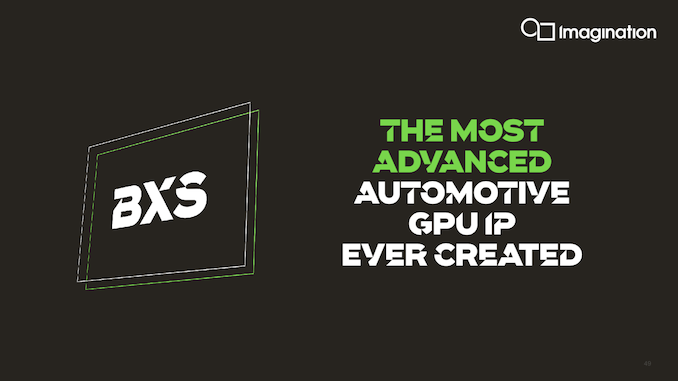
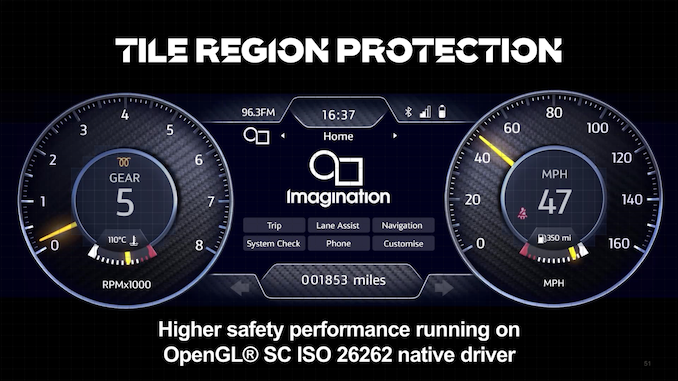
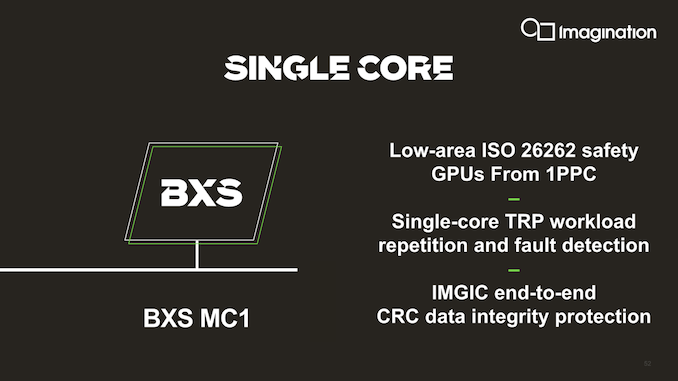
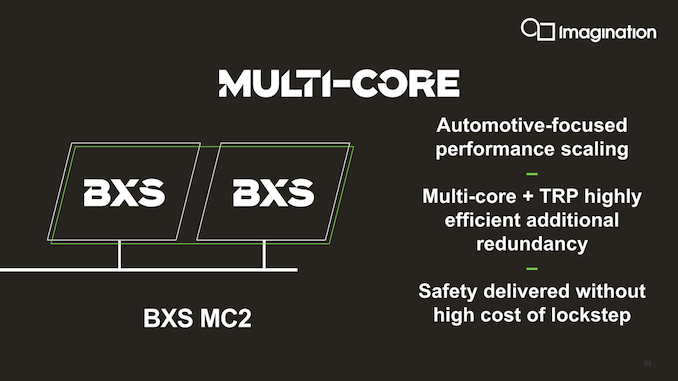
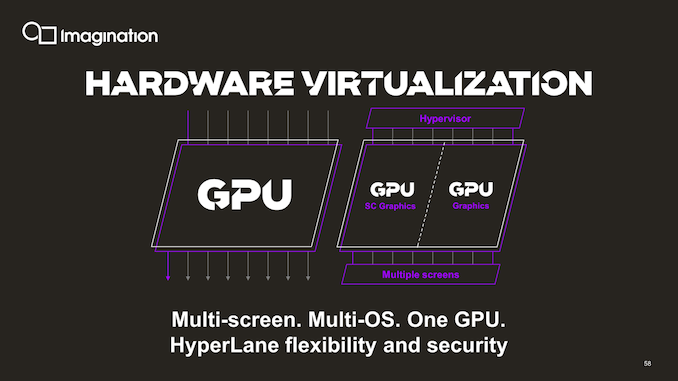
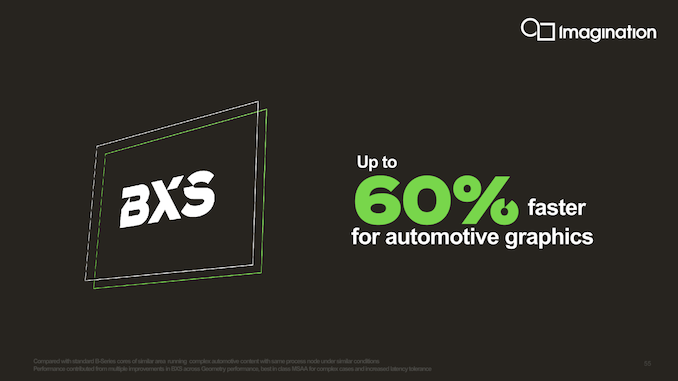








74 Comments
View All Comments
Threska - Wednesday, October 14, 2020 - link
"The MGPU seems like it will be the future of gpu computing, but right now putting multiple slabs of silicon together and efficiently connecting them is expensive and power hungry which is undesirable."https://www.digitaltrends.com/computing/google-sta...
lightningz71 - Tuesday, October 13, 2020 - link
Judging by their past performance with respect to drivers for windows platform systems, I wouldn't touch their desktop products with a ten foot pole until they have thoroughly demonstrated a willingness to:Provide a set of fully functioning drivers
Provide regular updates to those drivers to address bugs and odd behavior
Provide at the absolute least some framework for FOS drivers to be built for Linux
Provide a driver whad for standard linux desktops
Continue to provide these things for a period of several years
Because, up until now, they've done none of the above. Their last desktop product was an integrated gpu for Intel on an early Atom product. They, and Intel, promptly abandoned the product within months of releasing it, and never provided a single functional driver for the very next edition of Windows that was released within six months of the release of that processor. The drivers that were released for the existing windows version had rather basic functionality, were still buggy, and offered no useful video acceleration for any (at the time) modern video compression protocol.
So, they can release it all they want to, but I'm certainly not going near it for a long time.
29a - Tuesday, October 13, 2020 - link
They have tried before but they didn't do very well. I remember this card having a lot of hype before it was released.https://www.anandtech.com/show/735
myownfriend - Tuesday, October 13, 2020 - link
And a lot of people still talk about that card. That was one hell of a review.Threska - Wednesday, October 14, 2020 - link
Had the previous, and yes they were for the time period.Alexvrb - Wednesday, October 14, 2020 - link
The Kyros were great cards for their day, affordable and powerful.Lindegren - Wednesday, October 14, 2020 - link
They did, in 2001 - https://www.anandtech.com/show/735... but they focused on mobile instead, and that is why they are still here, unlike 3dfx and s3
Kel Ghu - Wednesday, October 14, 2020 - link
Imagination Tech's PowerVR tech started on PC. They left the market because their cards were not powerful enough and refocused on the mobile market, where their tech was more power-efficient. It's funny now to hear people asking them to come back to PC. And I'm all for it!myownfriend - Thursday, October 15, 2020 - link
That's not why they left. Imagination doesn't work like Nvidia or AMD. They don't make chips that others buy and place on boards for sale. Imagination makes source code for GPUs and in order for someone to make a graphics card out of it, someone needs to first license that code and make a physical chip.Nobody made a successor to the chip used in the Kyro II so nobody was able to release cards that used anything new after that.
In Anandtech's own article for the Kyro II it shows it outperforming cards that are twice the cost, use the twice the power, and have three times the fill-rate. It's limitation was that it didn't have a hardware T&L unit at the time but the next design would have.
EthiaW - Tuesday, October 13, 2020 - link
Why is the company still making futile investment to large GPUs such as BXT-16/32 without any forseeable customers? Just confused.